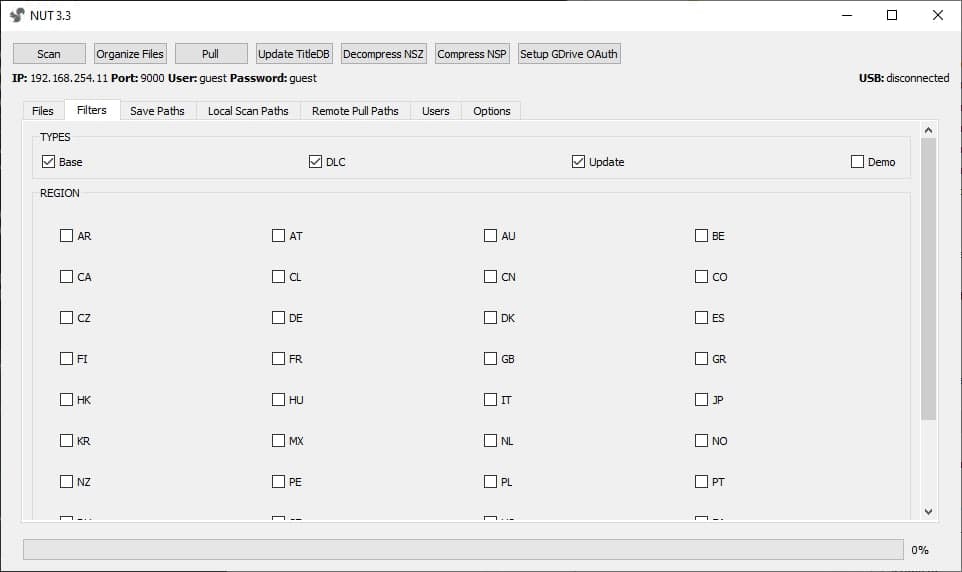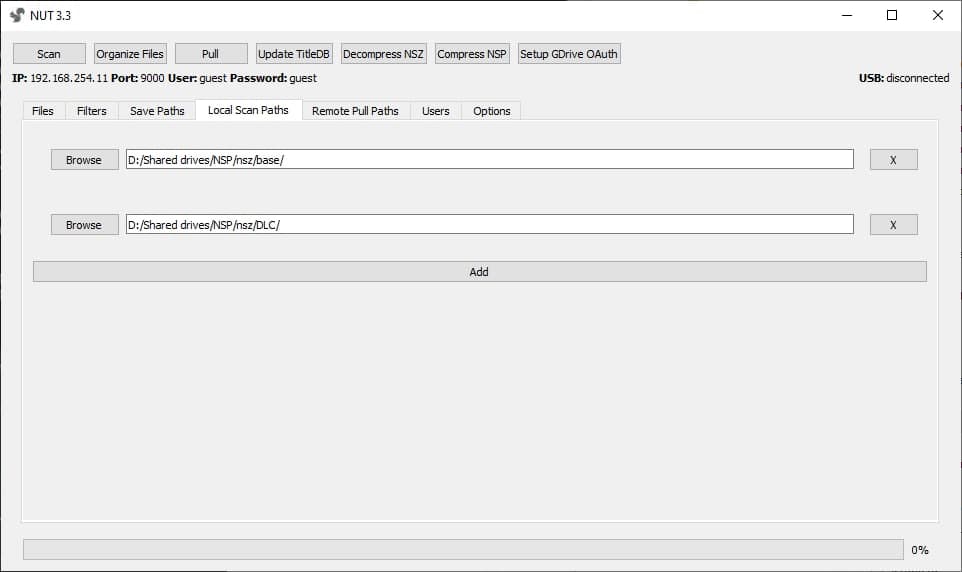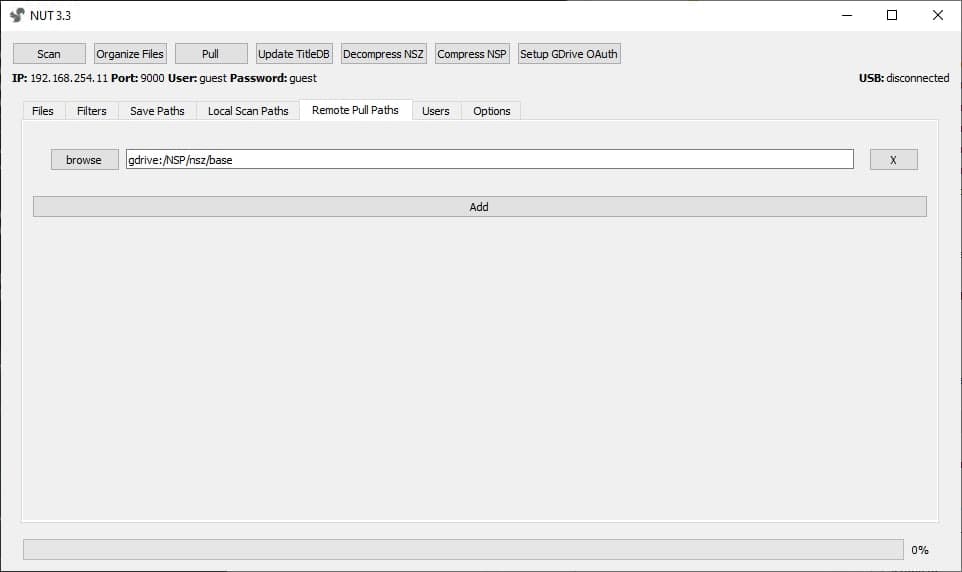Nut is a multi-purpose utility to organize, manage, and install Nintendo Switch files (NSP, NSZ, XCI, XCZ). It has the ability to act as a USB and network server for Tinfoil.
- Scan - populates file list
- Organize Files - moves files on disk to match the format specified in the configuration
- Pull - gets new files that match your filters from the remote locations (see configuration)
- Update TitleDB - force-reloads the latest title database
- Decompress NSZ - for any NSZ.XCZ files found, uncompresses them to NSP/XCI
- Compress NSP - for any NSP/XCI files found, compresses them to NSZ/XCZ CPU INTENSIVE
- Setup GDrive OAuth - see below
The GUI has the ability to set the most common configuration options, see the below images. You can also create a custom configuration by creating conf/nut.conf. The format should mirror nut.default.conf.
The IP/Port/User/Password are the information needed to login to the NUT server. To the right of those, you can also see a USB Status indicator, indicating whether a Tinfoil client is connected via USB with the server.
THe body shows a table containing a list of files that were detected by NUT from the scanned paths. It shows the title count, file name, title ID, title type and title size for each scanned file.
The footer shows the progress information of any file that is currently being downloaded from the server.
NUT has the ability to interact with Google Drive. For this to work, you will need to download a credentials.json, using the guide found here. Once you have this file placed either in NUT's root or conf directory, click the Setup GDrive OAuth button in the GUI and follow the prompts. You will be able to access your GDrive through Tinfoil via the gdrive:/ protocol after copying credentials.json and token.json to /switch/tinfoil on your microSD card. (This is automatically done if you connect Tinfoil to nut)
- Download
tinfoil_driver.exeandnut.exefrom here. - Install the drivers by running the
tinfoil_driver.exein the previous step. - Run
nut.exe. You should be presented with a GUI as shown in the picture above. - Install the latest version of Tinfoil and open it.
- Python 3.9+ (tested:
3.9.7) - OpenSSL-backed curl (for pycurl)
- Python modules as listed in
requirements.txt
Details
- Install Python 3.9+ from your preferred package manager, along with the
libusb,python3-pip&python3-pyqt5packages - Install
curlwith the openssl backend - installlibssl-dev(ie,apt install libssl-dev libcurl4-openssl-dev) - Clone this repository to desired directory and change your working directory to the cloned repository
- Install the PIP modules with the following command
pip3 install -r requirements.txt. If you previously tried installing pycurl and get the errorlibcurl link-time ssl backend (openssl) is different from compile-time ssl backend (none/other), uninstall it, make sure to follow step 2 again (installing curl with the openssl backend), andpip3 install pycurl --no-cache-dir - Add the following code snippet to
/etc/udev/rules.d/99-switch.rulesusing your favorite editor and reload (udevadm control --reload). Note: you may need to Disable MTP within Tinfoil and replace the group user with another that exists on your system. (based on this comment)
SUBSYSTEM=="usb", ATTRS{idVendor}=="057e", ATTRS{idProduct}=="3000", GROUP="plugdev"
SUBSYSTEM=="usb", ATTRS{idVendor}=="16c0", ATTRS{idProduct}=="27e2", GROUP="plugdev"
- Run
python3 nut_gui.pyto launch the application. (python3 nut.pyfor CLI)
Details
- Install Python 3.9 and PyQt5 via Homebrew (
brew install [email protected] pyqt@5) - Install pyenv: pyenv + pyenv-virtualenv (
brew install pyenv pyenv-virtualenvand follow install directions) - Install
libusb(brew install libusb) - Install
curlwith the openssl backend (brew uninstall --ignore-dependencies curl && brew install curl) - Install Python 3.9.7 with pyenv and set it as the default (
pyenv install 3.9.7 && pyenv global 3.9.7) - Load the system python's site-packages via pyenv's python. This is required to use PyQT5 from Homebrew.
- Get the Homebrew Python site-packages path (via
brew info [email protected]). - Add it to the load path of your pyenv's Python install (cd
pyenv root). - To do this, go to the site packages directory of your pyenv install (ie.
$HOME/.pyenv/versions/3.9.7/lib/python3.9/site-packages) and create an file namedhomebrew.pthcontaining the path for Homebrew Python's site packages directory (ie./opt/homebrew/lib/python3.9/site-packages) - For example, for M1, it would be:
cd $HOME/.pyenv/versions/3.9.7/lib/python3.9/site-packages && echo "/opt/homebrew/lib/python3.9/site-packages" >> homebrew.pth
- Get the Homebrew Python site-packages path (via
- Clone this repository to desired directory and change your working directory to the cloned repository
- Create a virtualenv and activate it. Note that your python path will be different if not on M1. (
pyenv virtualenv --system-site-packages --python=/opt/homebrew/bin/python3.9 nut && source activate nut) - Install wheel (
pip install wheel) - Install pycurl using the below.
on M1:
PYCURL_SSL_LIBRARY=openssl LDFLAGS="-L/opt/homebrew/opt/openssl/lib" CPPFLAGS="-I/opt/homebrew/opt/openssl/include" pip install pycurl --no-cache-dir
on Intel:
PYCURL_SSL_LIBRARY=openssl LDFLAGS="-L/usr/local/opt/openssl/lib" CPPFLAGS="-I/usr/local/opt/openssl/include" pip install pycurl --compile --no-cache-dir
- Install all other dependencies (
pip install -r requirements.txt) - Run
python nut.pyfor CLI. Runpython3 nut_gui.pyto launch the application (this will only work if PyQT from Homebrew was succesfully installed via directions above)
$ docker build --tag nut https://github.com/blawar/nut.git
$ docker run --rm -it --network=host --env=DISPLAY --volume=/tmp/.X11-unix:/tmp/.X11-unix --volume="$PWD:$PWD" --workdir="$PWD" --user=$(id -u):$(id -g) nutThis software is licensed under the terms of the GPLv3, with exemptions for specific projects noted below. You can find a copy of the license in the LICENSE file.
Exemptions:
- nsz is exempt from GPLv3 licensing and can license any source code from this project under the MIT License instead. In doing so, they may alter, supplement, or entirely remove the copyright notice for each file they choose to relicense.
Contributions are welcome, and there is a pre-commit hook - run pip3 install -r requirements_dev.txt



